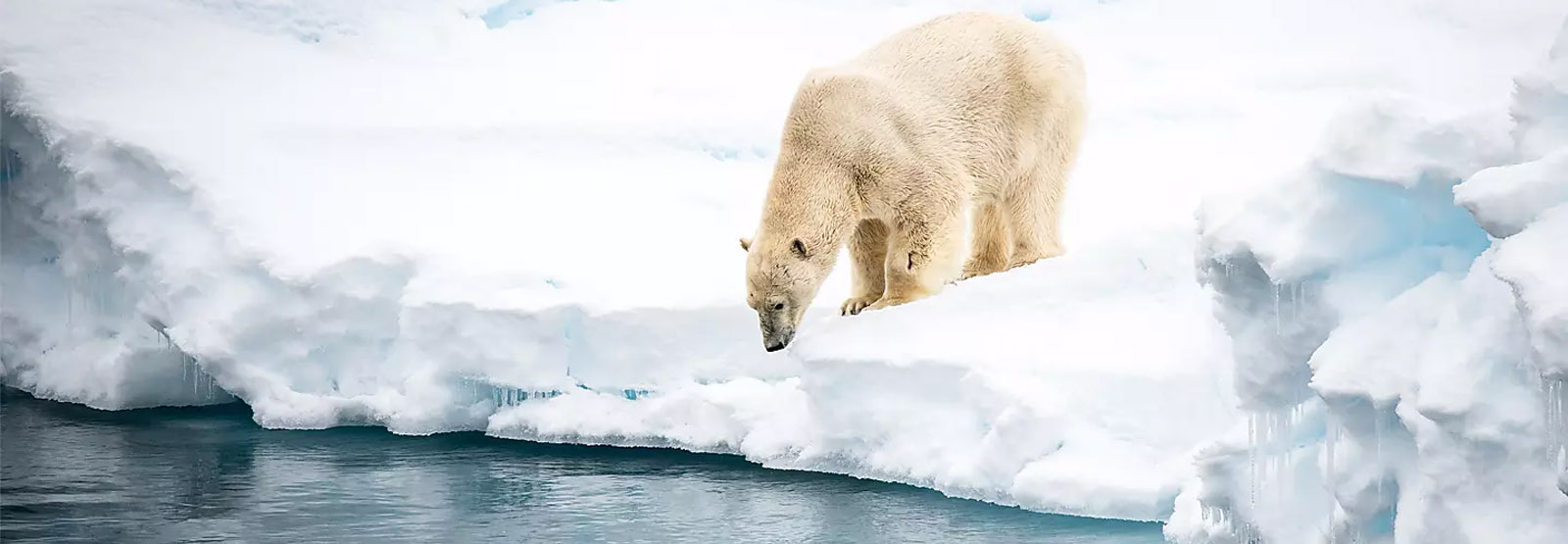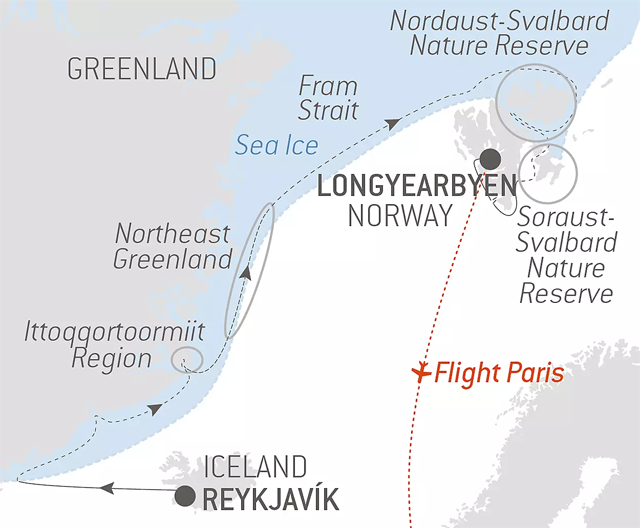HIGHLIGHTS
- Through
PONANT’s alliance with The Explorers Club, this voyage will
feature Vickie Siegel who works at the intersection of autonomous
robotics, polar research, planetary science, and cave exploration. This
voyage will also feature French-speaking Explorers Club member, Mike
Magidson, director of more than twenty documentaries and short films.
- We
also welcome Explorers Club Science Grantee, Dr. Adrian McCallum, Head
of Engineering at University of the Sunshine Coast. For his research
project, he will gather sea ice and oceanographic data from
seldom-explored regions, crucial for refining satellite observations
and climate models. Expect his findings to offer captivating narratives
and valuable insights.
- With
the presence of Nick Rains, Australian photo ambassador.
- Explore
the ice to the north-east of Greenland, inaccessible to traditional
ships in this extreme season (late spring), as well as the remote lands
of the Svalbard archipelago.
- Aboard
Le Commandant Charcot, a polar exploration vessel opening to the
exterior, take time to immerse yourself in unique moments of
exploration and observation, in the silence and respect of fragile
landscapes and encountered species.
- Discover
Nordaustlandet (North East Land), Europe’s largest ice cap.
- Explore
the Søraust-Svalbard Nature Reserve, the second largest
protected area in Norway.
- Sail
in the Hinlopen Strait, infiltrated by ice and connecting Spitsbergen
to Nordaustlandet.
- The
landscapes: mountains patterned with multi-coloured strata, fjords,
jagged mountains, glaciers, icebergs, ice floes, sheer cliffs, polar
ice cap, wild tundra.
- The
wildlife: polar bears, walruses, Arctic foxes, Svalbard reindeer,
whales, sea birds.
DATES / RATES
Rates are listed per person in USD
|
| Start Date | End Date | Prestige Stateroom Deck 6 | Prestige Stateroom Deck 7 | Prestige Stateroom Deck 8 | Deluxe Suite Deck 6 | Deluxe Suite Deck 7 | Deluxe Suite Deck 8 | Prestige Suite Deck 7 | Prestige Suite Deck 8 | Grand Prestige Suite Deck 6 | Privilege Suite Deck 8 | Suite Duplex | Owner's Suite |
|---|
Rates are listed per person in USD
|
| Start Date | End Date | (Starting from)
Prestige Stateroom Deck 6 | (Mid-range)
Prestige Suite Deck 7 | (High-end)
Owner's Suite |
|---|
Day
1: Reykjavík
Iceland’s
capital stretches along the edge of a vast bay in the west of the
country. Perlan, the “Pearl of
Reykjavík”, a museum located on
’Oskjuhlið hill, offers a panoramic view of the lush,
green landscapes. A little further, one can easily spot the signpost
showing the way to the evangelical Hallgrímskirkja church,
and to the historical centre where one can stroll along the
Skólavördustígur and the Laugavegur, two
lively streets with charming small shops. For some relaxation just
outside of the city, visitors have the opportunity to visit the
Reykjanes peninsula and its famous thermal lagoons of the Blue Lagoon.
Day
2: Sailing through the Denmark Strait
Lying
between Greenland and Iceland, the Denmark Strait was crossed for the
first time by theVikings in the late 10th century, during Erik the
Red’s expeditions. In the Second World War, its waters were
the theatre of a battle between the Kriegsmarine and the Royal Navy, on
24 May 1941. In the wintertime, extremely dense pack ice forms along
the Greenlandic coasts and, while the Transpolar Drift sweeps icebergs
along throughout the year, the strait is generally clear of ice during
the summer. In the depths of the strait lies the world’s
largest waterfall, an undersea cataract formed by the difference in
temperature between the cold waters of the Greenland Sea and the warmer
waters of the Irminger Sea. Numerous cetacean species thrive in this
rich ecosystem.
Day
3: Ammassalik Region
Still
almost unknown just a century ago, the east coast of Greenland remains
the most authentic and majestic region. Here, the alpine mountains
merge intimately with the sea, while the fjords are adorned with high
snow-capped peaks and drifting icebergs. Follow in the wake of Captain
Jean-Baptiste Charcot’s famous ship, the Pourquoi Pas?, which
set off with its crew to discover Ammassalik, a small island of
primitive and wild beauty where the Inuit people chose to live. The
name of this island is a reference to the capelin, a small flamboyant
silver coloured fish, whose presence in the thousands announces to
inhabitants the return of spring. A surprising discovery in a
spectacular setting.
Day
4: Blosseville Coast
Aboard
your ship, follow in the footsteps of Jules Poret de Blosseville, a
French explorer and sailor. In 1833, aboard La Lilloise, he set off to
discover this isolated and unexplored part of eastern Greenland and
gave French names to various sites on the coast. The adventure probably
has an unfortunate outcome, since the crew was never found. This
uninhabited territory, which now bears his name, lies to the south of
Scoresby Sund. Surrounded by ice, icebergs and pieces of pack ice,
Blosseville Coast is one of these wild and hard-to-reach places that
very few people are lucky enough to explore.
Day
5: Ittoqqortoormiit Region
On
the East coast of Greenland, in the Ittoqqortoormiit region, you will
have the rare opportunity of immersing yourself in the heart of
isolated scenery and exploring the beauty of its landscapes. The high
alpine mountains stand out in the sky, revealing dark rock edges. The
region is home to the longest fjord system in the world, Scoresby
Sound. On the edge of the fjord, the eponymous village is considered
one of the most remote inhabited places in the world. The colourful
houses, so typical of Greenland, dot the landscape with small red,
yellow and blue patches that stand out against the surrounding arid
landscape. Immersing yourself in this region will allow you to discover
the ancestral way of life of the last hunters of the polar region. This
will be a veritable deep-dive into the lives of the Arctic’s
inhabitants.
Days
6-9: Exploration of North-East Greenland
Set
sail for North-East Greenland to immerse yourself further and up higher
in the Arctic region to explore the unexpected riches of the sea ice,
where traditional ships cannot travel at this time of the year. As the
light shifts and the moods of the sky change, the different states of
the ice and the infinite diversity of its textures create an
exceptionally stunning tableau. With patience and humility, you will
sail amid the pearl-white floating cathedrals and the ice carried by
the Transpolar Drift. En route, icebergs have their journey halted by
ice and pressure ridges reveal their sharp edges. In the midst of this
icy vastness, beauty is found in the detail and the magic of the
moment. In the realm of polar bears, Le Commandant Charcot is a
reassuring cocoon built for polar exploration and offers you wonderful
opportunities to observe these lords of the ice when you happen upon
them. You may even get the chance to admire the moving sight of a
mother and her cub travelling across the immaculate icy expanse.
Days
10-11: At sea aboard Le Commandant Charcot
Spend
exceptional moments sailing aboard Le Commandant Charcot, the
world’s first luxury polar exploration vessel and the first
PC2-class polar cruise ship capable of sailing into the very heart of
the ice, on seas and oceans which the frozen conditions render
inaccessible to ordinary ships. Le Commandant Charcot is fitted with
oceanographic and scientific equipment selected by a committee of
experts. Take advantage of the on-board lectures and opportunities for
discussion with these specialists to learn more about the poles.
Participate in furthering scientific research with PONANT and let us
discover together what these fascinating destinations have yet to
reveal to us.
Days
12-13: Nordaust-Svalbard Nature Reserve
The
Nordaust-Svalbard Nature Reserve has been protecting the northernmost
and coldest part of the archipelago, Nordaustlandet (North East Land),
since 1973. This vast polar desert covered by two ice caps is the
second largest island in the Svalbard archipelago. Protected by the
Gulf Stream, the fjords and cliffs in the west and north are home to
large colonies of birds and walruses. The landscapes in the colder east
and south are dominated by imposing glaciers that calve majestic
icebergs in the vast Hinlopen Strait. Large colonies of thick-billed
murres have taken up residence on the sheer cliffs. You may even get
the chance to see a bear or an Arctic fox roaming in the vicinity.
Day
14: Sailing in the Hinlopen Strait
Sailing
in the Hinlopen Strait, in the heart of the Arctic Ocean, between the
Norwegian islands of Spitsbergen and Nordaustlandet promises an
unforgettable experience. This territory of the Nordaust-Svalbard
Nature Reserve offers breathtaking panoramas, with magnificent basalt
formations and the ice cap stretching as far as the eye can see, diving
into the sea. The shore line cut by the fjords moving inland composes a
magical landscape in which icebergs float here and there, the result of
the calving of the surrounding glaciers. This place, today a popular
spot to observe the seabirds nesting in the enormous cliffs, polar
bears and walruses, was once intrinsically linked to the history of the
whalers who frequented the region from the 17th century. Indeed, it was
one of them, Thijmen Jacobsz Hinlopen, then director of a Dutch whaling
company, who gave the strait its name. Later on, Russian trappers,
European explorers, scientists and even mountaineers roamed this
region, as hostile as it is sublime.
Day
15: Soraust-Svalbard Nature Reserve
The
Søraust-Svalbard Nature Reserve is the second largest
protected area in Norway. Established in 1973, this nature conservation
area stretching over more than 21,000 km2 will offer you stunning
panoramas including coastal landscapes, rocky islets, mountain
plateaux, vast tundra plains, and ice floes. With a little luck, you
will be able to observe a wide variety of seabirds, given the site is
listed as an Important Bird Area, as well as cetaceans, Svalbard
reindeer, or even Arctic foxes. Among other things, Edgeoya Island is
renowned for providing shelter to a number of polar bears during the
breeding season.
Day
16: Hornsund
Nestling
between millennial glaciers and carved mountains, and considered to be
“the crown of Arctic Norway”, Spitsbergen is a
place that never sees the night. Your ship will take you closer to this
fascinating archipelago and, more particularly, the Hornsund fjord.
Considered to be Svalbard’s southernmost fjord, it is
especially reputed to be its most stunning: at the end of its vast bay,
8 great glaciers slowly make their way down to the sea before giving
way to the many icebergs elegantly drifting along its cold and
mysterious waters.
Day
17: Longyearbyen, Spitsbergen
Longyearbyen
is the capital of the Norwegian Svalbard archipelago, located on
Svalbard’s main island, and is the northernmost territorial
capital on the planet. With winter temperatures dropping to below
40°C, the landscapes of this mining town are simply
breathtaking. The glaciers, the mountains stretching as far as the eye
can see and the untouched nature, make you feel like you’re
in completely unexplored territory.
 (Click image to view Ship details)
(Click image to view Ship details)
WHAT'S INCLUDED
- Flight Longyearbyen/Paris selected by PONANT in economy
class.
- Transfer as mentioned in the programme.
- English-speaking assistance.
Excluded
from this voyage:
- Personal expenses.
- Any other service not mentioned in the programme.
OPTIONAL ACTIVITIES
Adventure
Options:
- kayaking
- hiking or snowshoeing
- polar plunge.



